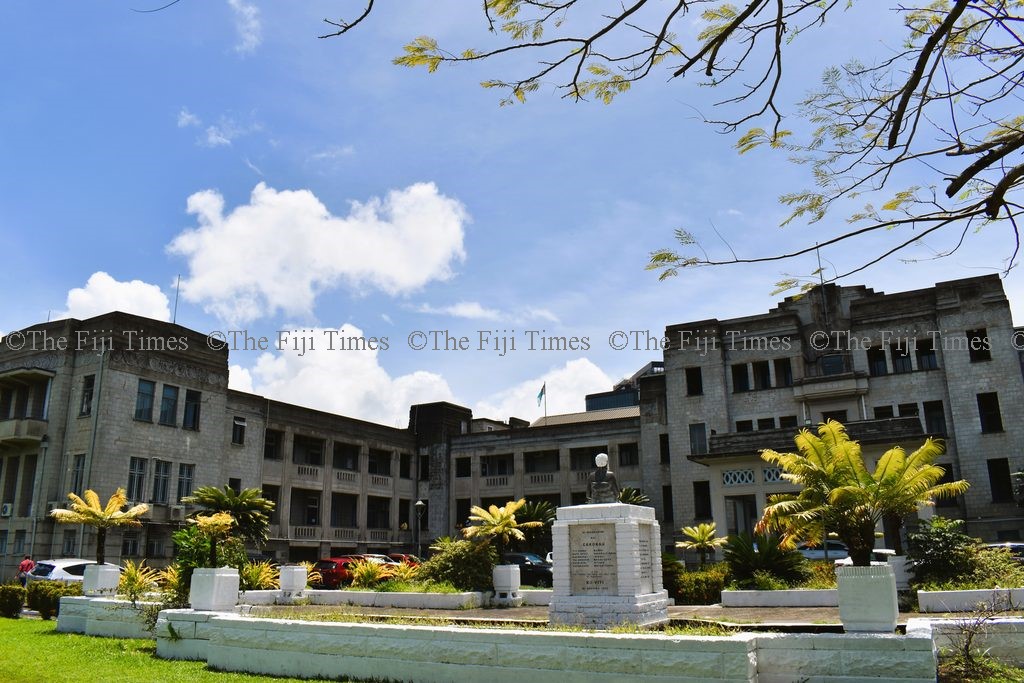Located in the heart of Fiji’s capital, Suva is the seat of our nation’s government.
As a daily commuter in Suva, citizen, or visitor from abroad, there is a likely possibility that you may not be fully aware of the historical significance and architectural uniqueness of the majestic grey concrete complex that we commonly refer to as Government Buildings.
Government Buildings and Government House.
What’s the difference?
It’s easy to confuse the two, even for someone born and bred in Suva. These two buildings however differ significantly in terms of their size, style, and purpose.
Government House, now known as the State House or Bai ni Kovana in iTaukei, is the current official residence of Fiji’s Head of State, the President.
It was constructed in 1926 and completed in 1928 when Fiji was still under British rule and so was built to serve as the official residence of the monarch’s representative in Fiji – the Governor and later the Governor-General after Independence in 1970, hence the term Bai ni Kovana (Governor’s residence).
To the north of the State House is Government Buildings.
These offices and chambers were built in the 1930s to serve as the executive wing of the Government of Fiji after the colonial administration of that time decided to relocate from Levuka to Suva.
From Naiqaqi to Government Budlings
The area from the present-day TLTB headquarters, Fiji Broadcasting Corporation (FBC), and much of the present-day Government Buildings used to be known as Naiqaqi in the late 1800s because it was the site of a sugar mill owned by Brewer and Joske and was built by a gentleman by the name of Leicester Smith in 1873.
According to the book, Suva: A History and Guide by Albert J. Schultz, up to 1935, the area on which Government Buildings stand today was mostly a swamp, about four feet below present road level, with the mouth of a creek at its centre.
Interestingly, Naiqaqi was known to be somewhat of a ‘red-light’ district and contained numerous shacks and informal housing that probably belonged to workers employed at the sugar mill.
To support the construction and stability of Government Buildings, more than three miles of reinforced concrete piles were driven down the creek bed, and in 1937, the foundation stone was laid by Governor Sir Arthur Richards.
The complex was designed by the chief colonial architect, Water Frederick Hedges OBE. Hedges had worked on various other projects in the Federated Malay States (Malaysia) and Africa. In 1939 the building was inaugurated by Governor Sir Harry Luke.
Legislative Council to Parliament
Government Buildings are equally divided, serving as both the seat of Fiji’s legislature and judiciary since its establishment.
From the time of its opening, it served as the home of the Legislative Council of Fiji, a law-making body that would later become the Parliament of Fiji after Independence.
Our nation’s political giants who walked through its halls and made historical speeches within it include the Ratu Sir Lala Sukuna, Ratu Sir Kamisese Mara, AD Patel, Siddiq Koya, Dr Timoci Bavadra, and Justice Jai Ram Reddy to name a few.
The main debating chamber which housed the council and today, the nation’s main lawmaking body, can be accessed from Constitution Avenue located alongside Albert Park.
As you enter the main central lobby, the vestiges of Fiji’s rich and proud colonial past are still very much visible on every corner of the building.
These include the British coat of arms on the base of the clock tower, two large marble tablets on the walls of the lobby containing the names of all of Fiji’s past Governors and Governors-General as well as the commemoration plaques and floral engravings on the walls and railings.
Parliament continued to meet here until the events of 1987. When parliamentary democracy was restored a few years later, parliament was shifted to a new complex in Veiuto in 1992, where it remained until the coup of 2006. After Fiji returned to its elected government in 2014, the parliament reconvened at its original home – Government Buildings.
Government Buildings today
The complex today is one of the busiest places in the country; apart from the usual court hearings that occur throughout the week, it is regularly packed with visiting government officials, students, journalists, and foreign dignitaries – especially when parliament is in session.
Apart from the debating chamber, the Speaker of the House, Leader of the Opposition, and Members of Parliament (MPs) offices are also based within Government Buildings, as well as the parliamentary library and information centre.
As for the judiciary, the Supreme Court and Fiji Court of Appeal have now permanently moved to the former parliamentary complex in Veiuto.
Several high courts and magistrate courts, as well as legal service offices, remain dotted around the building and the surrounding precincts.
85 years on, this jewel of our colonial past serves as a constant reminder to Fiji and its people, that despite the turbulence of our past, the rule of law and democracy must always prevail.



